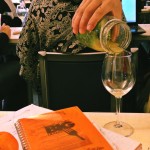Olive oil is not only a cornerstone to the Mediterranean diet, but also a versatile, must-have in the American kitchen and all over the world. No matter where the oil comes from (Spain, Italy, California…), these oils compliment different foods and uses. Yesterday Professor Bosticco clarified some basics that may help you to decide which… Continue reading A lesson in olive oil
Month: January 2013
Veneto surprise
On our first study trip last week, I looked forward to learning about the valpolicella, radicchio, grappa and cheese making that are typical to the Veneto region. These study trips are intended to immerse us in a region through visits to various producers, distilleries, agencies etc. to learn about products and processes within their environmental,… Continue reading Veneto surprise
The art of Bourgeoisie boozing
Mixology today is a master craft of cocktail creation, no matter the liquor or location, your beverage of choice has the power to elevate an entire experience. Restaurants and bars of all backgrounds host menus dedicated to drinks that transport you on a trip in taste — saketinis, jalepeno infused margaritas, and blood orange cosmopolitans are the simplest of examples.
Coming from New York City, where speakeasy’s and mixology bars literally ‘hide’ on every corner, I was curious if Europe, specifically Italy, would have the same talent feeding this posh addiction to creative libations. Perhaps I would find a suspender-clad-mustached -bohemian-bon vivant like the ones so stereotypical of New York – regardless of hipster accessories, some talent who had earned the trust of those who imbibe.
Upon arrival in Bra, we quickly learned of a local that opens sporadically, the bar fittingly named speak.easy. There, fellow students craft weekly cocktails to suit the weather, occasion, or simply using local ingredients that are seasonally available. At speak.easy we tried hot-toddies and gin infusions with elderflower, our new classmates always offering to make anything they had on hand in true bartender form. As our mixology professor pointed out to us: a sommelier explains, a chef creates, but a bartender encompasses the both of best to create something entirely new and perfect.
I myself have always had an interest in the classic cocktail – nothing overly sweet or complicated, but maybe an extra-dry martini or a bourbon old fashioned. One basic element that most of us don’t understand until post-college, is that the quality of a cocktail components is directly related to the final product – meaning the ingredients that go into it are, like anything, what make it good or bad. On that note, your perception of quality is what may elevate your appreciation for certain ingredients.
On my recent trip to Amsterdam, I was introduced to what I would call the Ward iii of Amsterdam, a bar called Vesper Bar in the Jordaan district. The ambiance of Vesper reminded me distinctly of TriBeCa’s Ward iii, the menu even hosting rules and the “luck of the draw” option. Both bars have extensive menus which allow for the option of a bespoke cocktail, giving the bartender freedom to create whatever he/she desires, as well as a list of respectful etiquette by which patrons are expected to comply.
As bars, restaurants and nightclubs increasingly adopt detailed menus, the boundaries of traditional mixology are being tested by cocktail competitions and molecular mixology. The interest in this is evident in the tastings and tours that are so commonly offered by brands and distilleries, even bars and restaurants. Without a doubt, beer, wine and liquor play as much a role in gastronomy as food, so perhaps with a special meal or on your next visit to a new city, seek out a twist on a traditional favorite!
My favorite mixologist, Cocktail Maestro Salvatore Calabrese: https://twitter.com/CocktailMaestro

